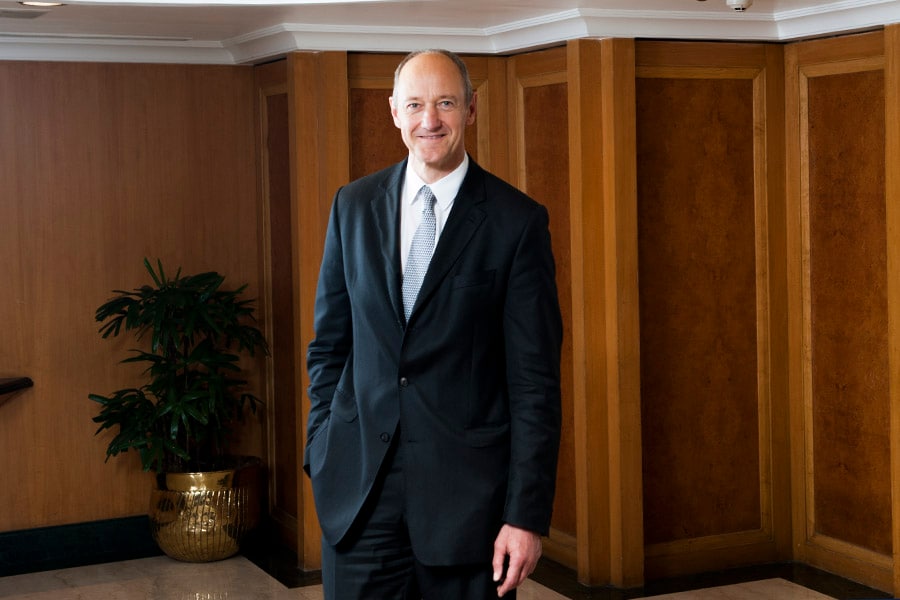
Digitalisation is not about taking away jobs: Siemens's Roland Busch
Roland Busch, chief technology officer and member of the managing board of Siemens AG, believes India is a good place to be in given its GDP growth and polices like 'Make in India'
 Roland Busch, chief technology officer, Siemens AG
Roland Busch, chief technology officer, Siemens AG German conglomerate Siemens AG, a leading supplier of systems for power generation and transmission as well as medical diagnosis, saw its revenue from digital technologies touch €5.2 billion in fiscal 2017, a 20 percent increase year-over-year. Of this, €4 billion was from software and the remaining from digital services.
“Digitalisation has a real purpose: Of lifting productivity to the next level, making better use of your assets which have a huge demand in the market… it’s about personalisation,” says Roland Busch, chief technology officer and member of the managing board of Siemens AG. “Digitalisation sits at the core of our strategy and investments too. It cuts across all industries that we are serving, in different shades.”
Siemens is pushing the envelope on digitalisation: From supporting pharmaceutical companies to enable better compliance with FDA regulations and faster migration from prototype to production to central monitoring and diagnostics for an entire fleet of assets for a power producer. Now at the forefront of its digital drive are MindSphere Application Centres, which the company started about 18 months ago.
MindSphere is a cloud-based, open Internet of Things (IoT) operating system that connects products, plants, systems and machines. The company claims it enables enterprises to harness data generated by IoT with advanced analytics. Each of the centres specialises in a particular industry in which Siemens is active. Approximately, a million devices and systems worldwide are connected via MindSphere, according to Siemens.
On May 10, Siemens announced the launch of four such centres in India, one each in Pune and Noida, and two in Gurugram. They will focus on offering digital solutions in the power sector in areas such as gas and steam turbines and smart grids. The company has 100 digitalisation projects underway for approximately 150 customers in India. “India continues to be a high-priority market for Siemens and we are taking the Fourth Industrial Revolution from concept to reality,” Busch tells Forbes India. Edited excerpts from an interview:
Q. How do customers benefit from your digitalisation services?
We know how to engineer a turbine, train and a health care device… we automate them. Now we bring the benefits of digitalisation on top of that. Siemens is one of the world’s top 10 software companies, creating digital solutions that enable customers to reduce costs, improve reliability and develop new business models. If you talk about industrial software—we can simulate anything from fluids, dynamics, electronics and mechanics… we can even simulate software. We can build a digital twin of a product or manufacturing site and simulate how it works. We can literally run a virtual product in a virtual manufacturing site. This avoids any kind of rework in the real world, which is extremely costly.
Q. Do these virtual products help lower overall costs for customers?
It [the reduction in cost] ranges from 8 to 30 percent. And the cycle time (or go to market time) can be shortened by 40 to 50 percent. It depends on how far one wants to push the envelope and the industry in which the technology is being deployed. And there is no industry which Siemens is not serving.
Q. Could you tell us about your MindSphere Application Centres?
At our MindSphere Application Centres, we invite customers to join us and share with us their targets, pain points and what they want to achieve. However, an automotive customer has a different problem than a pharmaceutical one. It’s not a one-size-fits-all where in the morning you can solve an energy problem, a train issue in the afternoon and a heath care one the day after. We started this concept a year-and-a-half ago and now we have 20 centres globally, including four in India. They start with a bunch of about 20 people and can grow to about just over a hundred individuals. We don’t grow them in size (ramping up employee headcount); we grow them in terms of quality.
Q. Does digitalisation mean less jobs?
I don’t see it like that. It requires different jobs (with people with different skill sets). For example, at our plant at Amberg, Germany, where we have this digital twin, the same number of people (1,200) have been working over the last 15 years. Yet, its topline grew eight-fold. Would you say that it takes jobs away? Obviously not. But the jobs 10 years ago definitely looked different than the ones you see currently. The key point about digitalisation is not about taking jobs away, but how to train people in a way to bring more digitalisation in their play. The cycle time of digital technologies is short and people have to learn faster and continuously.
Q. Digitalisation apart, how important is India as market for Siemens globally?
According to the last quarter (December 2017 to March 2018), our India business grew by more than 20 percent. Overall, it’s one of the highest growing markets and businesses for Siemens, globally. Besides, with a GDP growth rate of 7 percent-plus, which is huge, and the policy and strategy of the country—Make in India is something we fully subscribe to and support—it’s a good place to be in. We have about 23,000 people working here, 30 percent of whom are involved in research and development (R&D). And this is a high share of R&D talent. Globally, we have 360,000 people working for us of which 50,500 (or 14 percent) are in R&D. In India, of the 6,800-odd people working in R&D, 3,000 are in the digital space.
X




